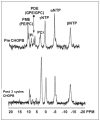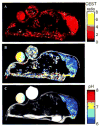High-field small animal magnetic resonance oncology studies
- PMID: 24374985
- PMCID: PMC4389287
- DOI: 10.1088/0031-9155/59/2/R65
High-field small animal magnetic resonance oncology studies
Abstract
This review focuses on the applications of high magnetic field magnetic resonance imaging (MRI) and spectroscopy (MRS) to cancer studies in small animals. High-field MRI can provide information about tumor physiology, the microenvironment, metabolism, vascularity and cellularity. Such studies are invaluable for understanding tumor growth and proliferation, response to treatment and drug development. The MR techniques reviewed here include (1)H, (31)P, chemical exchange saturation transfer imaging and hyperpolarized (13)C MRS as well as diffusion-weighted, blood oxygen level dependent contrast imaging and dynamic contrast-enhanced MRI. These methods have been proven effective in animal studies and are highly relevant to human clinical studies.
Figures

















Similar articles
-
Assessment of Hypoxia in Breast Cancer: Emerging Functional MR Imaging and Spectroscopy Techniques and Clinical Applications.J Magn Reson Imaging. 2025 Jan;61(1):83-96. doi: 10.1002/jmri.29424. Epub 2024 May 4. J Magn Reson Imaging. 2025. PMID: 38703143 Review.
-
The role of magnetic resonance imaging in oncology.Clin Transl Oncol. 2010 Sep;12(9):606-13. doi: 10.1007/s12094-010-0565-x. Clin Transl Oncol. 2010. PMID: 20851801
-
Simultaneous characterization of tumor cellularity and the Warburg effect with PET, MRI and hyperpolarized 13C-MRSI.Theranostics. 2018 Sep 9;8(17):4765-4780. doi: 10.7150/thno.25162. eCollection 2018. Theranostics. 2018. PMID: 30279736 Free PMC article.
-
An Update on MR Spectroscopy in Cancer Management: Advances in Instrumentation, Acquisition, and Analysis.Radiol Imaging Cancer. 2024 May;6(3):e230101. doi: 10.1148/rycan.230101. Radiol Imaging Cancer. 2024. PMID: 38578207 Free PMC article. Review.
-
Diffusion-weighted imaging and dynamic contrast-enhanced MRI of experimental breast cancer bone metastases--a correlation study with histology.Eur J Radiol. 2015 Apr;84(4):623-30. doi: 10.1016/j.ejrad.2015.01.002. Epub 2015 Jan 19. Eur J Radiol. 2015. PMID: 25641009
Cited by
-
Clinical application value of 3.0T MR diffusion tensor imaging in grade diagnosis of gliomas.Oncol Lett. 2017 Aug;14(2):2009-2014. doi: 10.3892/ol.2017.6378. Epub 2017 Jun 13. Oncol Lett. 2017. PMID: 28781644 Free PMC article.
-
Intratumoral heterogeneity of breast cancer xenograft models: texture analysis of diffusion-weighted MR imaging.Korean J Radiol. 2014 Sep-Oct;15(5):591-604. doi: 10.3348/kjr.2014.15.5.591. Epub 2014 Sep 12. Korean J Radiol. 2014. PMID: 25246820 Free PMC article.
-
Characterization of the Tumor Microenvironment and Tumor-Stroma Interaction by Non-invasive Preclinical Imaging.Front Oncol. 2017 Jan 31;7:3. doi: 10.3389/fonc.2017.00003. eCollection 2017. Front Oncol. 2017. PMID: 28197395 Free PMC article. Review.
-
Tumor stroma interaction is mediated by monocarboxylate metabolism.Exp Cell Res. 2017 Mar 1;352(1):20-33. doi: 10.1016/j.yexcr.2017.01.013. Epub 2017 Jan 26. Exp Cell Res. 2017. PMID: 28132882 Free PMC article.
-
Bridging the translational gap: Implementation of multimodal small animal imaging strategies for tumor burden assessment in a co-clinical trial.PLoS One. 2019 Apr 8;14(4):e0207555. doi: 10.1371/journal.pone.0207555. eCollection 2019. PLoS One. 2019. PMID: 30958825 Free PMC article.
References
-
- Aboagye EO, Bhujwalla ZM. Malignant transformation alters membrane choline phospholipid metabolism of human mammary epithelial cells. Cancer Res. 1999;59:80–4. - PubMed
-
- Ackerman JJ, Grove TH, Wong GG, Gadian DG, Radda GK. Mapping of metabolites in whole animals by 31P NMR using surface coils. Nature. 1980;283:167–70. - PubMed
-
- Ackerstaff E, Pflug BR, Nelson JB, Bhujwalla ZM. Detection of increased choline compounds with proton nuclear magnetic resonance spectroscopy subsequent to malignant transformation of human prostatic epithelial cells. Cancer Res. 2001;61:3599–603. - PubMed
-
- Agris PF, Campbell ID. Proton nuclear magnetic resonance of intact Friend leukemia cells: phosphorylcholine increase during differentiation. Science. 1982;216:1325–7. - PubMed
-
- Aime S, Delli Castelli D, Terreno E. Highly sensitive MRI chemical exchange saturation transfer agents using liposomes. Angewandte Chemie. 2005;44:5513–5. - PubMed
Publication types
MeSH terms
Substances
Grants and funding
LinkOut - more resources
Full Text Sources
Other Literature Sources
Medical
